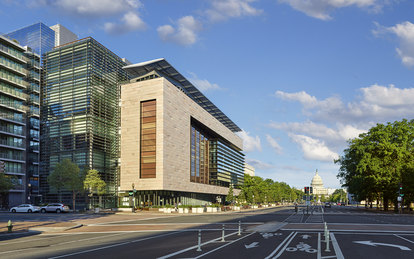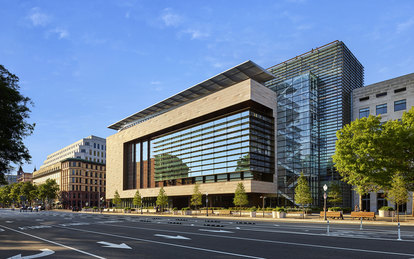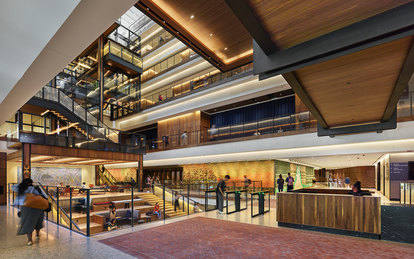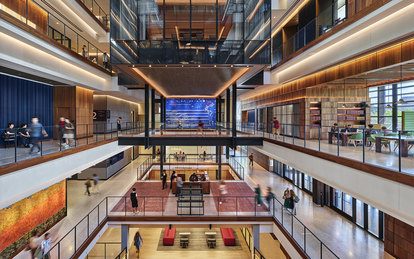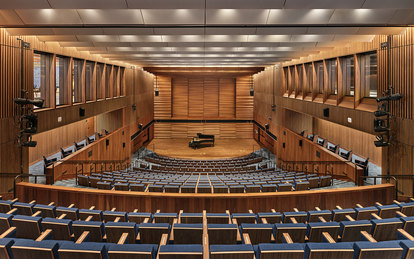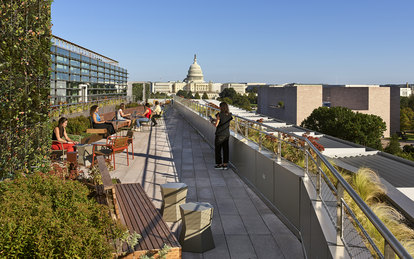Johns Hopkins University Bloomberg Center
A thorough redesign converts a prominent Pennsylvania Avenue museum into a modern learning environment for graduate education, research and event programming.
Client
Johns Hopkins University
Location
Washington, DC
Markets/Services
Architecture, Higher Education, Learning & Innovation Spaces, Lighting Design, Professional Education
Size
435,000 sf
Featured Awards
LEED Silver Certification
When the Newseum (a public museum devoted to journalism) closed in 2019, Johns Hopkins University saw an opportunity to consolidate its D.C.-based programs into a single hub that fosters collaboration among academic disciplines and deepens the university’s connection to national and global policy leaders.
The repositioned building, designed in collaboration with Ennead Architects and Rockwell Group, takes full advantage of its Pennsylvania Avenue location, across from the National Gallery of Art and just blocks from the U.S. Capitol. Substantial floorplate alterations on multiple levels enable more than 300,000 square feet of space for learning, convening and other programming. It features 38 technology-enabled classrooms that support lecture format and collaborative group work, a multi-media recording studio, a 375-seat auditorium, and conference space with views of the Capitol and National Mall. It firmly establishes a greater identity for Johns Hopkins in the District of Columbia, with long-term flexibility as the university’s D.C. programs and pedagogy evolve and expand.
SmithGroup conducted extensive visioning with the client—including the university president and leadership from each of its schools—to determine the balance of program types and the space needed to accommodate them, but also help the schools understand how space could be shared effectively between their programs. The existing interior, however, didn’t readily function for academic use: Glass elevators whisked visitors up the multi-story atrium, and a long winding ramp spiraled around perimeter exhibits back to the ground floor. The team needed to reconstruct the slabs to create level floors with equal and appropriate heights, and then reconfigure each floor to optimize space for future flexibility of program and create more traditional circulation patterns. Utilization analyses and test fits led to the demolition of roughly 50,000 square feet and the reconstruction of 90,000 square feet for a net gain of usable space. Student learning and collaboration spaces are sited around the atrium, creating an urban, vertical take on the classic academic quad.
Thanks to SmithGroup’s significant experience working on government buildings and cultural institutions in the District of Columbia, the design team successfully secured multiple regulatory approvals, including from the U.S. Commission of Fine Arts that oversees projects in the “monumental core” of the city. Anticipating the long lead time for exterior renovation approvals due to the high-profile location, the team began with the façade. Removing the former museum’s iconic marble panel from the exterior enabled the design team to create a more light-filled interior. The new Pennsylvania Avenue façade expands the front bar with copper-tinted glass framed in warm limestone and relocates the ground-floor entrance to activate the surrounding streetscape. Concealed exterior illumination and a soft glowing interior core seen through the glazing creates a contextually respectful yet unique nighttime identity for the school. Future plans include a restaurant to further enliven the street interface and integrate the Johns Hopkins community into the neighborhood.
The conversion has created a powerful Washington presence for Johns Hopkins. It unites the School of Advanced International Studies, Carey Business School, Krieger School of Arts & Sciences, the Peabody Institute and the newly established School of Government and Policy under one roof and creates a base where students and faculty from the university’s other divisions can pursue research and education in the nation’s capital. The Hopkins Bloomberg Center at 555 Pennsylvania Avenue, NW, is now a place of new vibrancy and relevance, where the thought leaders of today enlighten the policymakers of tomorrow.
